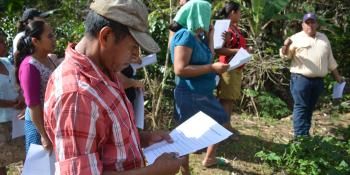Climate finance for agricultural adaptation: challenges and opportunities

A new working paper examines climate finance mechanisms relevant to agricultural adaptation and how they are set up and managed, with respect to governance, funding scope, eligibility, and social inclusiveness.
Turning the Paris Climate Agreement into action, and with the formal signing of the Agreement just having taken place, it’s time to seize the moment and re-instate the argument for agricultural adaptation. Broader adaptation and resilience goals cannot be attained if agriculture doesn’t get significant additional support, both due to the low capacity, high exposure, and overall vulnerability of the sector.
Research has already identified several technically and economically feasible adaptation potentials, including mature and scalable technologies, management methods, and institutional arrangements. Though, despite recognizing the importance of coping with climate change and agriculture at the same time, great financial gaps exist and hamper the actual implementation of agricultural adaptation. Financial support, both in the form of climate finance and “traditional” agricultural finance, is therefore critical in order to materialize those potentials.
According to the Climate Policy Initiative, in its landmark report for 2013, only 7% of the total climate finance (about USD 25 billion) went to adaptation, and among the total adaptation finance, only 8% (about USD 2 billion) was allocated to agriculture and forestry related activities. Most recently, and based on an early analysis of the Intended National Determined Contributions (INDCs), although 80% and 64% of the Parties have included agriculture in their mitigation targets and adaptation strategies, respectively, only 10% of the Parties have specified financing requirements and have identified mechanisms for agricultural adaptation. Moreover, evaluations on the effectiveness of existing agricultural finance mechanisms, especially in relation to the emerging climate finance landscape, are largely unavailable, revealing a data and information gap in this area.
A recent study by the CGIAR Research Program on Climate Change, Agriculture and Food Security (CCAFS) reviewed 37 climate finance mechanisms related to agriculture adaptation with the aim to understand the big picture of the funding landscape for agricultural adaptation, from both the supply and demand side, identify challenges and opportunities, and detect research areas, that can lead to a more effective, transparent, and efficient financial system for agriculture adaptation.
Key findings:
- Identified agricultural adaptation related finance mechanisms have very different interpretations for adaptation, which may lead to unclear financing targets, barriers to tracking financial flows, and difficulties for applicants to demonstrate eligibility.
- Public funds are the major funding sources for current agricultural adaptation finance mechanisms. Contribution from the private sector remains low but shows great potential and indicates the needs for more active and innovative engagement.
- By reviewing existing governance structures, public participation, and information disclosure, greater efforts are needed to strengthen public engagement and improve impartiality and transparency.
- Future research can help to: (a) Offer clarity on the definition (scope and range) for agriculture adaptation, identify synergies between different funding purposes and improve efficiency of resource allocation; (b) Understand the needs of potential funding recipients and inform the financial mechanisms for better program design, while building recipients’ readiness; (c) Develop general policies and databases for financial reporting to track the flows and enhance strategic planning and accountability; (d) Enhance engagement with the private sector and mobilize and scale up private capital by exploring innovative participation and investment models that serve multiple objectives of agricultural adaptation, food security, and economic growth; (e) Build an evidence base to identify suitable actions to meet agricultural development goals under climate change, study farmers’ investment patterns, and design mechanisms that could lead farmers’ investment behavior towards appropriate adaptation actions; and (f) Specify agricultural adaptation costs at different scales and propose related financing mechanisms and instruments.
Download the working paper:
Ye W, Vasileiou I, Förch W. 2016. Climate finance for agricultural adaptation. CCAFS Working Paper no. 155. Copenhagen, Denmark: CGIAR Research Program on Climate Change, Agriculture and Food Security (CCAFS).
Wenlu Ye is a Master’s in Development Practice student at Emory University. Ioannis Vasileiou is an Agricultural Specialist at the World Bank's Agriculture Global Practice, supported by CCAFS and IFPRI.



